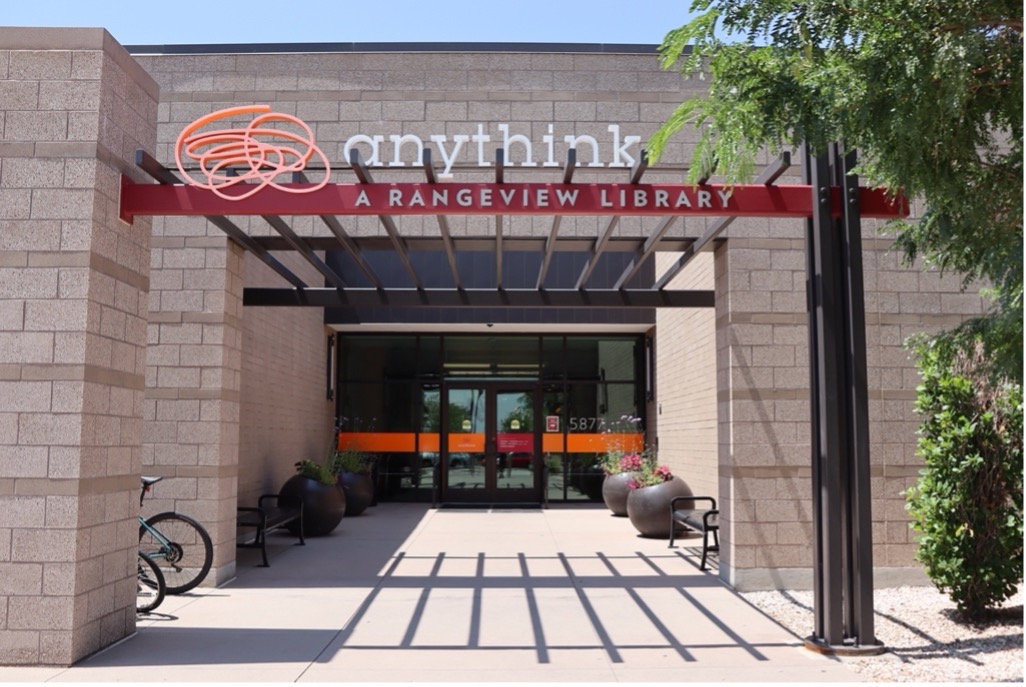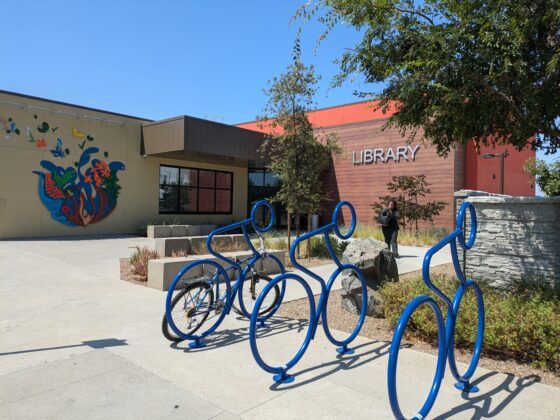Anythink Libraries Serve Adams County Through a Spirit of Hospitality and Innovation.
On a very hot August Colorado summer afternoon, the back patio of Anythink Libraries, with its picnic tables, art installations, and fire pits for the colder weather is bustling with parents, children, and older visitors. I joined Pam Sandlian-Smith, Anythink’s Director, and Erica Grossman, its Innovations Manager, for coffee at the Anythink Café to continue Our Towns reporting on the library’s creative mission and culture.
Just about everything at Anythink is creative, from its formation into a multiple-community system of seven branch libraries and a bookmobile, to its name, which emerged when the library rebranded in 2009. “Anythink represents the democratic ideal of a public library,” said Pam, the founding director, who has built her career turning around libraries. “Anything you want to know, discover, think, or master can be found at your library.”
The modern-day story of Anythink began in 2004, when the Adams County library, which was the poorest-funded library system in Colorado at the time, became a special taxing district. After two failed attempts, voters approved a mill levy increase in 2006, which secured a more robust operating budget.
Approximately 70 percent of Adams County, stretching north of Denver toward Weld County and east to include the Eastern Plains of Colorado, is under the age of 50. Pam’s goal was to be inviting and accessible to the young population.
“We just moved from the place where everything was about, ‘let’s protect and organize these books and make everything perfect’ to ‘let’s be a library that’s really about supporting people and helping them be successful, whatever their endeavors are’,” Pam says.

The full-service café at the entrance of Anythink Libraries is stocked with coffee, tea, sandwiches, and snacks to serve guests. All photo credits: Allie Kuroff.
Here are some of the Anythink innovations: In 2009, Anythink Libraries replaced the outdated, numeric-based Dewey Decimal system with WordThink, an instinctive category-based organizing system for its books, and eliminated fines on late materials. When Covid-19 forced the libraries to close in 2020, they opened up a telephone call center for seniors and adjusted their mySummer learning programs to be digital and mailed journals to kid’s homes. The Anythink team has also created district-wide initiatives, including healthy farmer’s markets, Civic Saturdays, Spark (a quarterly publication delivering news of local interest), and a Bicycle lending library.
To humanize the library system and work towards making it a “Great Equalizer” (as Pam describes here in the Anythink launch video in 2009), she took her cues from the hospitality industry, where she worked before pivoting into the library world. She used the lens of hospitality to imagine what a library experience could be for everyone who walked through its doors.
“Hospitality is knowing someone is on [the customer’s] side,” Pam says. “That infuses everything we do, which is really trying to be on people’s side. We don’t always have the exact thing that they want. But we can always let them know that we’re on their side.”
This approach drives every part of the visitor experience at all branches, as well as Anythink in Motion, the bookmobile, which brings the library to residents outside the county service area. The bookmobile is “meeting people where they are at,” as Erica says.
“We’re looking for opportunities where we can connect with someone coming through our doors, recognize what level of service they need, and be able to help them achieve their goals – whether that is something as simple as coming in for book, or something as ambitious as starting a business or learning to woodwork,” Erica says.
Even the language used at Anythink Libraries has been intentionally selected to foster a culture of belonging and inclusion. Visitors at the library are referred to as “customers” and “guests.” Librarians are “guides.”
“When we’re rethinking the libraries to be more people-oriented to get focused on hospitality, thinking about folks as guests and customers was just one way that we could help do that,” Erica says. “Just reframing your relationship to the folks walking through your doors to not be something transactional but to be something that’s more focused on being a guest and being a human and being someone that we can serve.”
Language and experience intersect at the back patio, which the staff refers to as “the backyard.”
“We use this space often. It connects us to the neighborhood,” Pam says. “You see people wandering in and kids coming in on their bikes.”
As Pam and Erica guide me through a tour, they describe how the library’s physical spaces were designed to foster a sense of discovery.
The library’s children’s section is decorated with renditions of Colorado Aspen trees.
The book stacks in Anythink Libraries have enough space to promote what Pam refers to as “roaming,” a common consumer practice in retail stores.
Giving guests the space to freely wander about is important, Pam says, because it allows staff members to check on guests, answer questions they have, or point them in the right direction if their wanderings turned into a quest.

Fostering a sense of connectedness to the natural world at the library is an intentional strategy used by the Anythink team to promote whimsy and discovery.
As a final stop, we visit the library’s adjacent community garden, where members of the community can – for free – maintain one of the 28 plots. In collaboration with Denver Urban Gardens, which operates more than 180 community gardens throughout the Metro Denver area, Anythink provides 37 additional organic community garden plots at two other branches, for members to plant veggies, flowers, herbs, or anything else, in exchange for maintaining the plots, keeping weeds and pests at bay, and helping keep community walkways and picnic areas clear.
As for measuring success, which can be elusive, Pam says, “We feel like our work is to help our community feel healthy, happy, and safe. And the more we work towards that, and the more that we participate in that intentionally, the better off our community is.”
From the café to the backyard, from the garden plots to rentable bicycles, from roaming spaces to an environment where excitement is encouraged, Anythink Libraries serves as a model of how experimenting with unexpected strategies to meet community needs – of health, happiness, and safety, as Pam says – leads to new ventures and discoveries – much the same way books have done and will continue to do for young and old library goers alike for generations to come.




